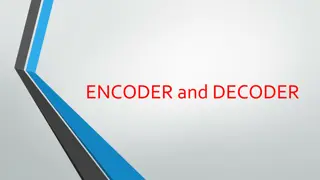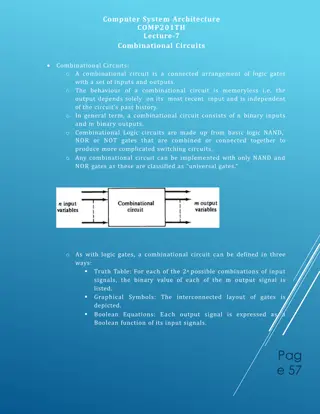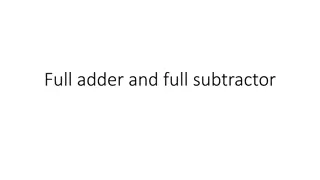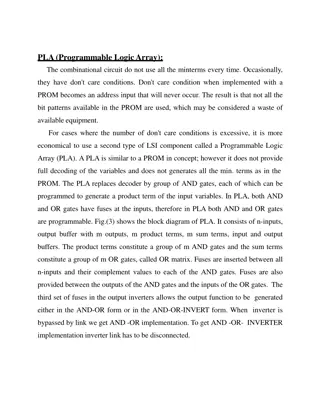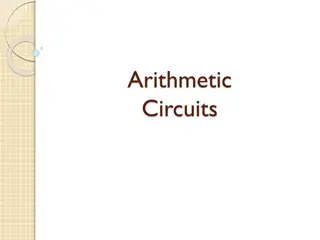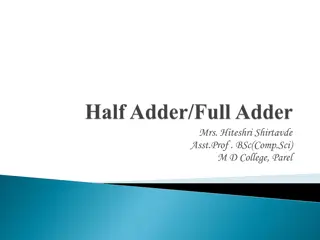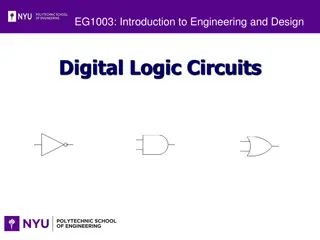Understanding Combinational Circuits in Computer Science
Explore the fundamentals of combinational circuits in computer science, including adders, subtractors, half adders, and full adders. Learn about circuit design, optimization, and manipulation of equations to enhance computational efficiency.
Download Presentation

Please find below an Image/Link to download the presentation.
The content on the website is provided AS IS for your information and personal use only. It may not be sold, licensed, or shared on other websites without obtaining consent from the author. Download presentation by click this link. If you encounter any issues during the download, it is possible that the publisher has removed the file from their server.
E N D
Presentation Transcript
College of Computer and Information Sciences Department of Computer Science CSC 220: Computer Organization Unit Unit 5 5 COMBINATIONAL CIRCUITS COMBINATIONAL CIRCUITS- -1 1
Unit 5: Combinational Circuits-1 Overview Overview Introduction to Combinational Circuits Adder Ripple Carry Adder Subtraction Adder/Subtractor Chapter-3 M. Morris Mano, Charles R. Kime and Tom Martin, Logic and Computer Design Fundamentals, Global (5th) Edition, Pearson Education Limited, 2016. ISBN: 9781292096124
Adder Adder Design an Adder for 1-bit numbers? 1. Specification: 2 inputs (X,Y) 2 outputs (C,S)
Adder Design an Adder for 1-bit numbers? 1. Specification: 2 inputs (X,Y) 2 outputs (C,S) 2. Formulation: X 0 0 1 1 Y 0 1 0 1 C 0 0 0 1 S 0 1 1 0
Adder Design an Adder for 1-bit numbers? 1. Specification: 3. Optimization/Circuit 2 inputs (X,Y) 2 outputs (C,S) 2. Formulation: X 0 0 1 1 Y 0 1 0 1 C 0 0 0 1 S 0 1 1 0
Half Adder This adder is called a Half Adder Q: Why? X 0 0 1 1 Y 0 1 0 1 C 0 0 0 1 S 0 1 1 0
Full Adder A combinational circuit that adds 3 input bits to generate a Sum bit and a Carry bit
Full Adder A combinational circuit that adds 3 input bits to generate a Sum bit and a Carry bit Sum YZ X 0 0 0 0 1 1 1 1 Y 0 0 1 1 0 0 1 1 Z 0 1 0 1 0 1 0 1 C 0 0 0 1 0 1 1 1 S 0 1 1 0 1 0 0 1 X 00 01 11 10 0 1 0 1 S = X Y Z + X YZ + XY Z +XYZ 0 1 1 0 1 0 = X Y Z Carry YZ X 00 01 11 10 0 0 1 0 0 1 0 1 1 1 C = XY + YZ + XZ
Full Adder = 2 Half Adders Manipulating the Equations: S = X Y Z C = XY + XZ + YZ
Full Adder = 2 Half Adders Manipulating the Equations: S = ( X Y ) Z C = XY + XZ + YZ = XY + XYZ + XY Z + X YZ + XYZ = XY( 1 + Z) + Z(XY + X Y) = XY + Z(X Y )
Full Adder = 2 Half Adders Manipulating the Equations: S = ( X Y ) Z C = XY + XZ + YZ = XY + Z(X Y ) Think of Z as a carry in Src: Mano s Book
Bigger Adders How to build an adder for n-bit numbers? Example: 4-Bit Adder Inputs ? Outputs ? What is the size of the truth table? How many functions to optimize?
Bigger Adders How to build an adder for n-bit numbers? Example: 4-Bit Adder Inputs ? 9 inputs Outputs ? 5 outputs What is the size of the truth table? 512 rows! How many functions to optimize? 5 functions
Ripple Carry Adder Ripple Carry Adder To add n-bit numbers: Use n Full-Adders in parallel The carries propagates as in addition by hand Use Z in the circuit as a Cin 1 0 0 0 0 1 0 1 0 1 1 0 1 0 1 1
Binary Parallel Adder To add n-bit numbers: Use n Full-Adders in parallel The carries propagates as in addition by hand Src: Mano s Book This adder is called ripple carry adder
Subtraction (2s Complement) How to build a subtractor using 2 s complement?
Subtraction (2s Complement) How to build a subtractor using 2 s complement? 1 Src: Mano s Book S = A + ( -B)
Adder/ Adder/Subtractor Subtractor How to build a circuit that performs both addition and subtraction?
Adder/Subtractor 0 : Add 1: subtract Src: Mano s Book Using full adders and XOR we can build an Adder/Subtractor! Ahmad Almulhem, KFUPM 2009
Binary Parallel Adder (Again) To add n-bit numbers: Use n Full-Adders in parallel The carries propagates as in addition by hand Src: Mano s Book This adder is called ripple carry adder
Carry Look Ahead Adder How to reduce propagation delay of ripple carry adders? Carry look ahead adder: All carries are computed as a function of C0 (independent of n !) It works on the following standard principles: A carry bit is generated when both input bits Ai and Bi are 1, or When one of input bits is 1, and a carry in bit exists Cn Cn-1 .Ci .C2C1C0 An-1 .Ai .A2A1A0 Bn-1 .Bi .B2B1B0 Carry bits Carry Out Sn Sn-1 .Si .S2S1S0
For Review 24


